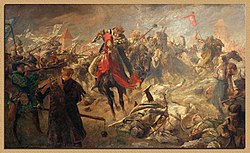Jagiellon dynasty
The Jagiellons were a royal dynasty that came from Lithuania and reigned in some Central European countries (present day Lithuania, Belarus, Poland, Ukraine, Latvia, Estonia, Kaliningrad, parts of Russia, Hungary, Czech Republic, Slovakia) between the 14th and 16th century.
Members of the dynasty were grand dukes of Lithuania 1377–1392 and 1440–1572, kings of Poland 1386–1572, kings of Hungary 1440–1444 and 1490–1526, and kings of Bohemia 1471–1526. The family was a branch of the Lithuanian Gediminaičių dynasty.
The name (other variations used in English include: Jagiellonians, Jagiellos, Jogailos, Jagiellas) comes from Jogaila (pol.: Jagiełło), the first Polish king of that dynasty.[1]
Jagiellon rulers
Jagiellons were hereditary rulers of Poland and Lithuania.
The Jagiellon rulers of Poland–Lithuania (with dates of ruling in brackets) were:
Jagiellon Dynasty Media
Seal of Jadwiga of Poland, the last hereditary ruler of Poland and Jogaila's first wife.
Jogaila, later Ladislaus II Jagiełło (c. 1352/1362 – 1 June 1434) was Grand Duke of Lithuania (1377–1434), King of Poland (1386–1399) alongside his wife Jadwiga, and then sole King of Poland.
Baptism of Władysław III of Poland at Wawel in 1425
The Crusade of Varna was a series of events in 1443–44 between the crusaders and the Ottoman Empire, culminating in a devastating Christian loss at the Battle of Varna on 10 November 1444.
Ladislaus III during battle of Varna, where he disappeared.
Thirteen Years' War – Battle of Chojnice in 1454
Malbork Castle during Thirteen Years' War (1460)
Footnotes
- ↑ In Polish, the dynasty is known as Jagiellonowie (singular: Jagiellon, adjective, used of dynasty members, also patronimical form: Jagiellończyk); in Lithuanian it is called Jogailaičiai (sing.: Jogailaitis), in Belarusian Яґайлавічы (Jagajłavičy, sing.: Яґайлавіч, Jagajłavič), in Hungarian Jagellók (sing.: Jagelló), and in Czech Jagellonci (sing.: Jagellonec; adjective: Jagellonský), as well as Jagello or Jagellon (fem. Jagellonica) in Latin. In all variations of that name, the letter J should be pronounced as in "Hallelujah" (or as Y in "yes"), and G – as in "get".
Other websites
- Pages and Forums on Lithuanian history Archived 2020-09-22 at the Wayback Machine
- Jagiellonian Observatory









